Review of PLAXIS 3-D version 2013.01

Review of PLAXIS 3-D version 2013.01 |
|

|
|
|
HOME
PLAXIS 3-D |
Review of Geotechnical Software | |
|
Updated 30.03.16 Review of PLAXIS 3-D
Intro
PLAXIS 3-D is in my opinion the current available best 3-D geotechnical software and can be used for just about all geotechnical problems.
It has great soil models ranging from Mohr Coulomb to soft soil creep model which is very accurate for offshore geotechnical problems in soft clay.
Despite the sophistication geotechnical software, it is still rather user-friendly.
ProblemA 1 m high foundation with extension of 2 x 5 m is placed on clay with a constant undrained shear strength of 5 kPa with elastic module of 300x5 kPa. A surface load is placed on the structure and a point load is applied one of the upper corners. The horizontal load and create both overturning and torsion. This is included in the classic bearing capacity assessment where I have utilised NC = 6.17. Since it mainly is sliding problem, then the bearing capacity factor does not have a major impact on the calculation. The problem is illustrated below. 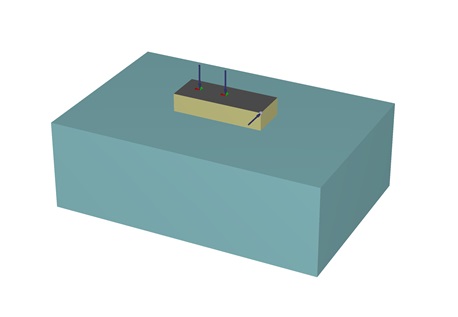
I did not experience creating the structure to be very easy since this was my first attempt ever to use the software. With some experience, I believe it will be rather easy to create the structure. When you delete elements, loads and so on, I experienced the software broke down a few times. Luckily, my model was automatically saved each time. ResultsA sensitivity study has been completed in order to determine the accuracy dependency of elements. It takes approximately less than 1 min to run one bearing capacity analysis with 7000 elements are a few minutes with 22,000 elements and too long to wait with 84,900 elements. The result of the sensitivity analysis is given below with the bearing capacity for Nc equals 5.14 and 6.17: 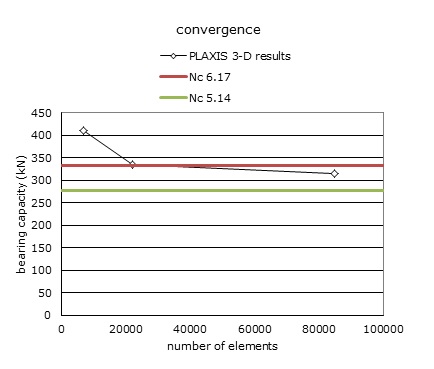
Upon review of the failure mechanism, it is seen that the results with in 22,000 elements predicts a failure mechanism which is slightly less accurate than the failure mechanism with 84,900 elements which is more in line with the expected failure mechanism. This illustration is given below: 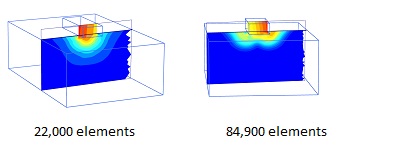
For the given problem, the displacement and load diagram does not predict a pure plastic behaviour. Failure is therefore defined at the end of the elastic behavior. This is the major challenge with PLAXIS 3D, that it is a finite element analysis software and predicting the ULS load is always mesh dependent and step depending. It is therefore not possible to accurately determine if the collapse load has been identified. An example of the displacement and loads diagram is given below. 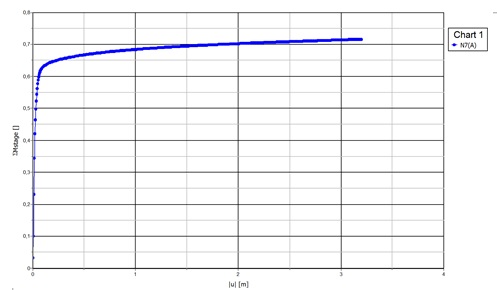
PLAXIS 3-D has a number of great tools to illustrate the results. It is possible to gain a great overview of the displaced mesh, cross sections can be made to identify slip lines in the soil, it is possible to see plastic points and finally the displacement load diagram can easily be plotted. 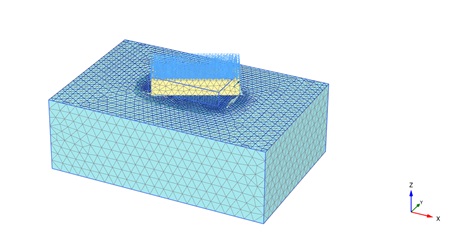
The results are since then, a stability envelope for the classic bearing capacity formulation in line with brinch Hansen and compared to the result of the PLAXIS 3-D model for Nc 6.17. Notably, the results are given for no tension cut off. That means that the full base area in the PLAXIS model contributes to horizontal capacity. It is therefore expected that there will be additional resistance from the PLAXIS 3-D model in sliding capacity. The stability envelopes are presented below: 
A relatively large discrepancy is found between the horizontal load applied compared to the static equilibrium equation proposed by brinch Hansen. It would therefore be necessary to run and analysis with tension cut off to investigate if a more refined results and the PLAXIS 3-D analysis can be obtained. At the same time, the equation proposed by brinch Hansen may be on the conservative side. Conclusion
PLAXIS 3-D has been used to compared to the results of a static equilibrium model proposed by brinch Hansen for torsional loaded foundations.
PLAXIS 3-D has found to be relatively easy to use. It is a very comprehensive software and substantial geotechnical experience is required
to get the full benefit of the software. Also, it is not a software usually expect to get good results from without some experience with finite
element modelling in PLAXIS.
|
Evaluation |
Evaluation 1-6 (6 highest) |
Ease of Use |
|
Accuacy |
|
Technical Support |
|
Speed of Analysis |
|
Grafics |
      |
Overall |
      |